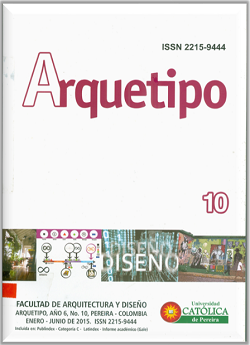Life cycle assessment model assisted by informatic tools, as support of the ecodesign teaching strategies at university level.
Keywords:
Ecodesign, Life Cicle Assessment (LCA), teaching strategies, sustainability, informatics toolsAbstract
Eco-design is an innovation methodology with the objective of decreasing environmental impacts in the product life cycle. The best-known ecodesign
methodology is life-cycle assessment (LCA). This document presents the design and evaluation of LCA models aided by informatic tools as eco-design teaching support in a Colombian university. Eco-design teaching diagnosis, improvement scenarios and strategies were defined by triangulation of data from mixed research and the testing of LCA models .The active participation of the academic community is the way to promote ecodesign teaching and its contribution to sustainable development.
References
AENOR (1998). Norma UNE-EN ISO 14040:1998. Gestión ambiental. Análisis del ciclo de vida. Principios y estructura.
Bereketli, I. & Genevois, M. E. (2013). An integrated QFDE approach for identifying improvement strategies in sustainable product development. Journal of cleaner production (54), 188-198.
Capuz, S., Gómez, T., Vivancos, J. L., Viñoles, R., Ferrer, P., López, R. Y Bastante, M. J. (2004). Ecodiseño: Ingeniería del ciclo de vida para el desarrollo de productos sostenibles. Valencia: Alfaomega.
Chang, D., Lee, C. & Chen, C. (2014). Review of life cycle assessment towards sustainable product development. Journal of cleaner production, Volumen 83, 2014, Paginas 48–60.
Charter, M. & Tischner, U. (2001). Sustainable Solutions. Sheffield: Greenleaf Publishing.
Cieri, D., Garetti & Terzi. (2009). Product Lifecycle Management Approach for Sustainability. Proceedings for the 19th CIRP Conference.
Comisión Mundial de Medio ambiente y Desarrollo (1987).Nuestro futurocomún. Oxford: Oxford University Press.
Ehrenfeld, J.(2005). The roots of sustainability. MIT Sloan Management Review,46(2), 23-25.
Glavič, P. & Lukman, R. (2007). Review of sustainability terms and their definitions. Journal of Cleaner Production, Volumen 15, 2007, 1875 - 1885.
Howarth, G. & Hadfield, M. (2006). A sustainable product design model. Materias & Design (27), 1128-1133.
Lofthouse, V. (2006). Ecodesign tools for designers: Defining the requirements. Journal of Cleaner Production (14), 1386-1395.
Masui, K., Sakao, T., Kobayashi, M., & Inaba, A. (2003). Applying quality function deployment to enviromentaly conscious design. International Journal of Quality & Reliability Management (20), 90-106.
Mc Donough, W. (1992). The Hannover Principles. Charlottesville: William McDonough Architects.
McMichael, A., Butler, C. & Folke, C. (2003). New visions for addressing sustainability. Science (302), 1919-1920.
Programa de las Naciones Unidas para el Medio Ambiente (2007). Diseño para 37 la sostenibilidad: Un enfoque práctico para las economías en desarrollo. Bonn:Delft University of Technology
Quacquarelli Symonds (2014). QS Latin American Universities. Recuperado de http://www.topuniversities.com/university- rankings/latin-american-university-rankin gs/2014#sorting=rank+ region=+country=357+faculty=+stars=false+search=
SolidWorks (2014). SolodWorks sustainability software. Recuperado de http:// www.solidworks.es/sustainability/ sustainability-software.htm
Universidad Industrial de Santander (2012). Estatuto General. Bucaramanga: Ediciones UIS.
van Hemel, C. & Brezet, H. (1997). Ecodesign: a promising approach to sustainable production and consumption. UNEP Industry and Environment.
Veshagh, A. & Obagun, A. (s.f.). Survey of sustainable life cicle design and management. En: Advances in Life Cycle Engineering for Sustainable Manufacturing Buisnesses (pp. 237-242). Londres: Springer.
Vinodh, S. & Rathod, G. (2010). Integration of ECQFD and LCA for sustainable product design. Journal of cleaner production (18), 833-842.
White, M. (2013). Sustainability: I know it when I see it. Ecological Economics (36), 213-217.

